Wet Waste Management Market Size and Trends
The global wet waste management market is estimated to be valued at USD 134.78 Bn in 2025 and is expected to reach USD 150.72 Bn by 2032, growing at a compound annual growth rate (CAGR) of 1.6% from 2025 to 2032.
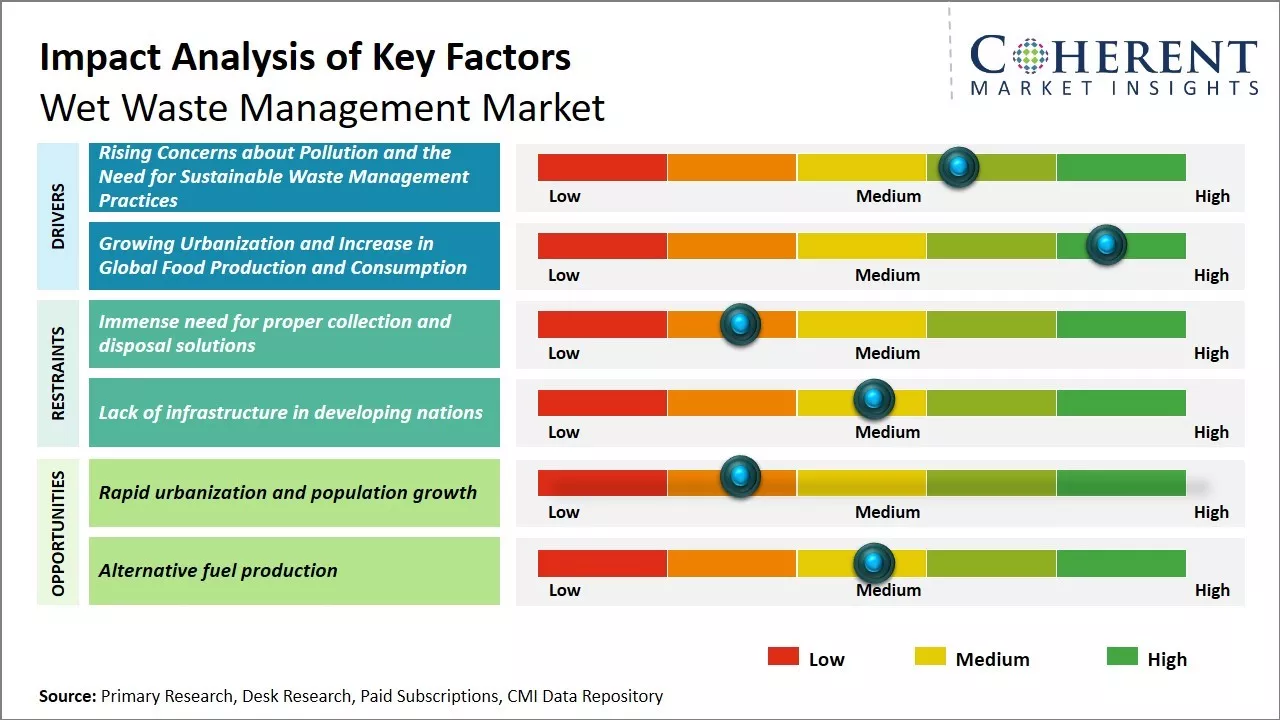
Discover market dynamics shaping the industry: Download Free Sample
Wet waste management practices are evolving with increases in urbanization and sustainability initiatives. There is a growing focus on efficient waste collection and segregation methods to increase recycling and reduce dumping in landfills. Advancements in digestion technologies are allowing for the conversion of food waste into useful byproducts like biogas and fertilizers. New regulatory pushes and policies and rising awareness among citizens are encouraging municipalities to adopt modernized waste management systems. The long term trend reflects a transition towards a circular economy model with maximized resource recovery from wet waste streams.
Rising Concerns about Pollution and the Need for Sustainable Waste Management Practices
Wet waste, such as food scraps and green waste, accounts for a large portion of garbage sent to landfills and incinerators every year, where they take up valuable space and release greenhouse gases as they break down. However, more people are realizing the harmful environmental impact of sending biodegradable materials to landfills. The decomposition of wet waste in anaerobic conditions at landfills produces methane, a potent greenhouse gas that is many times more damaging to the climate than carbon dioxide. There is also the issue of valuable resources being wasted when food scraps and yard trimmings are not composted or converted into renewable energy. More countries and communities are recognizing the need to adopt sustainable waste management solutions to deal with wet waste in an environmentally friendly manner through options like composting, anaerobic digestion and waste to energy. Strict regulations are being put in place in many parts of the world to mandate source separation of wet waste and ban biodegradable materials from landfills. Consumer demand is also increasing for sustainable waste management practices and eco-friendly disposal options. As ecological concerns rise up the global agenda, more investments will flow into developing infrastructure and technologies for treating wet waste in a manner that protects the environment.
Market Concentration and Competitive Landscape
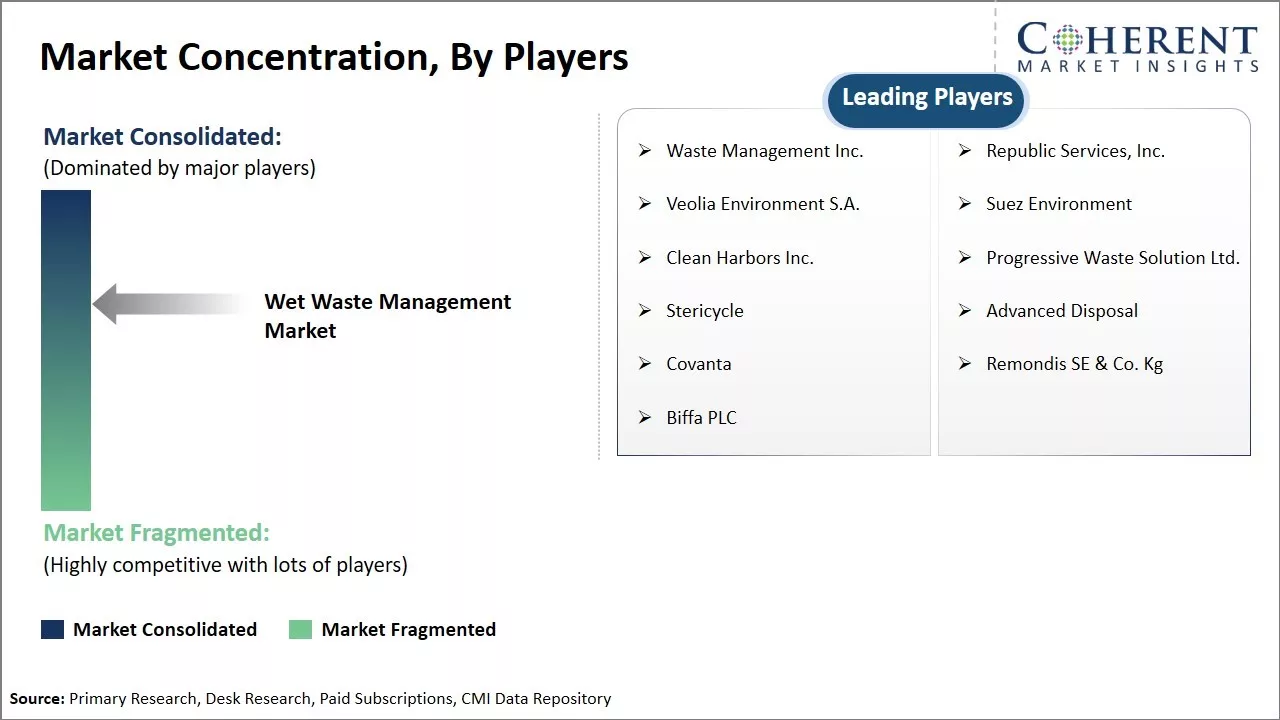
Get actionable strategies to beat competition: Download Free Sample
Growing Urbanization and Increase in Global Food Production and ConsumptionRapid urbanization is another key driver behind the growth in wet waste volumes worldwide. As more people migrate to cities, waste generation increases considerably due to higher population densities and changed consumption patterns in urban areas compared to rural regions. Food waste alone is estimated to account for over 1 Bn tons of municipal solid waste globally each year. Meanwhile, improving economic conditions are boosting food expenditures around the world. Rising incomes translate to greater demand for resource-intensive Western diets higher in meat and dairy, as well as increased year-round availability of out-of-season produce through global supply chains. Food production is also scaling up worldwide to meet the nutritional needs of a growing global population projected to reach nearly 10 Bn by 2050. All these interlinked trends are pushing up the amounts of wet waste—particularly food scraps—entering the waste stream on a daily basis from households, retail outlets, institutions and industries like food manufacturing. This makes large-scale, scientific wet waste management solutions an infrastructure priority for cities.
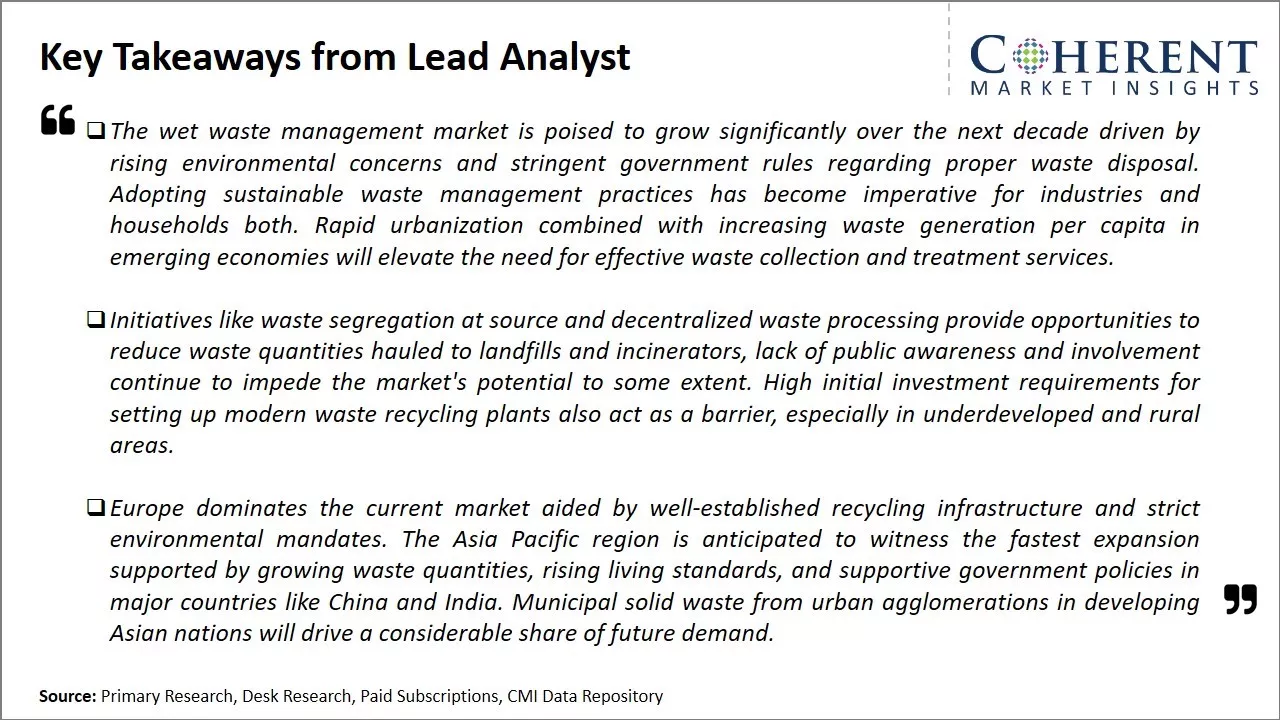
To learn more about this report, Download Free Sample
Market Challenges: Immense need for proper collection and disposal solutions
The global wet waste management market faces several challenges. Large amounts of wet waste are produced daily worldwide, creating an immense need for proper collection and disposal solutions. However, current infrastructure and technologies are insufficient in many areas. Financial and resource constraints also limit the ability of municipalities to establish efficient waste management systems, especially in developing nations. Public awareness and engagement regarding proper waste segregation and disposal is still lacking in some regions. Environmental regulations on landfills and incineration are becoming more stringent globally as well.
Market Opportunities: Rapid urbanization and population growth
Significant opportunities exist for players in the global wet waste management market. Rapid urbanization and population growth are increasing the volumes of waste generated worldwide. Many nations are framing new policies and laws to mandate proper waste management practices. This is driving the need for innovative collection, transport, and treatment solutions. Technologies like anaerobic digestion and waste-to-energy plants present monetization.
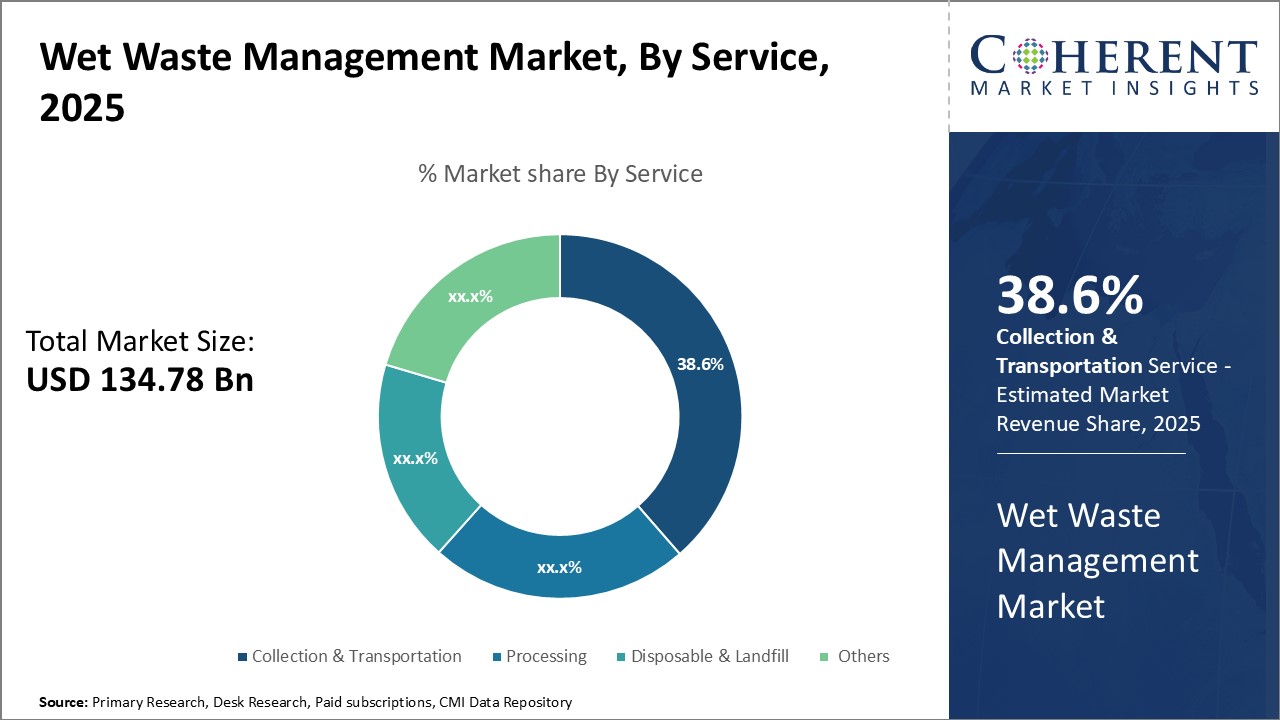
Discover high revenue pocket segments and roadmap to it: Download Free Sample
Insights, By Service: The high volume of waste collected from various sources on a daily basisAs per the given data, the collection & transportation segment contributes the 38.6% share in the global wet waste management market in terms of service. This is mainly due to the high volume of waste collected from various sources on a daily basis, which makes collection and subsequent transportation an integral and vital part of the overall waste management process.
Collection and transportation of wet waste involves door-to-door pickup and hauling of segregated wet waste from households, businesses, institutions and other establishments to intermediate processing facilities or final disposal sites such as landfills or composting plants. It requires a large fleet of waste collection vehicles and employment of thousands of waste collectors across the world. The high operational costs associated with managing this network of vehicles, assets and human resources have led collection & transportation to emerge as the largest revenue generator for wet waste management companies.
Furthermore, regular and timely collection of wet waste is of critical importance from public health and hygiene perspective especially in densely populated urban areas. Municipal authorities regard investment in robust collection infrastructure as a top priority to prevent disease outbreak and maintain sanitation standards. This acts as a major growth driver for the collection & transportation segment.
Insights, By Source: The industrial waste stream is more homogenous in nature compared to the mixed waste from other sources
As per the available details, the industrial segment accounts for the 40.8% share within the global wet waste management market in terms of source. Large industrial establishments such as food processing plants, slaughterhouses, dairies, breweries, and pharmaceutical companies generate huge volumes of wet waste on a daily basis from their manufacturing operations. Proper handling and disposal of this industrial wet waste is crucial to uphold environmental compliance and process safety norms.
The industrial waste stream is more homogenous in nature compared to the mixed waste from other sources. This makes the collection, transport and recycling/treatment process more efficient. Moreover, industrial units usually sign long term contracts with wet waste management vendors for hauling out their waste on a daily/weekly basis. This regular revenue stream makes the industrial source segment highly lucrative for service providers.
Stringent regulatory restrictions on industrial disposal of wet waste through conventional methods such as landfills are another major factor propelling adoption of advanced recycling and waste-to-energy solutions. This increases the revenue potential of industrial waste management. In light of these aspects, the consistency in waste generation and regulatory push have helped the industrial segment emerge as the largest in terms of source for the global wet waste management industry.
Regional Insights
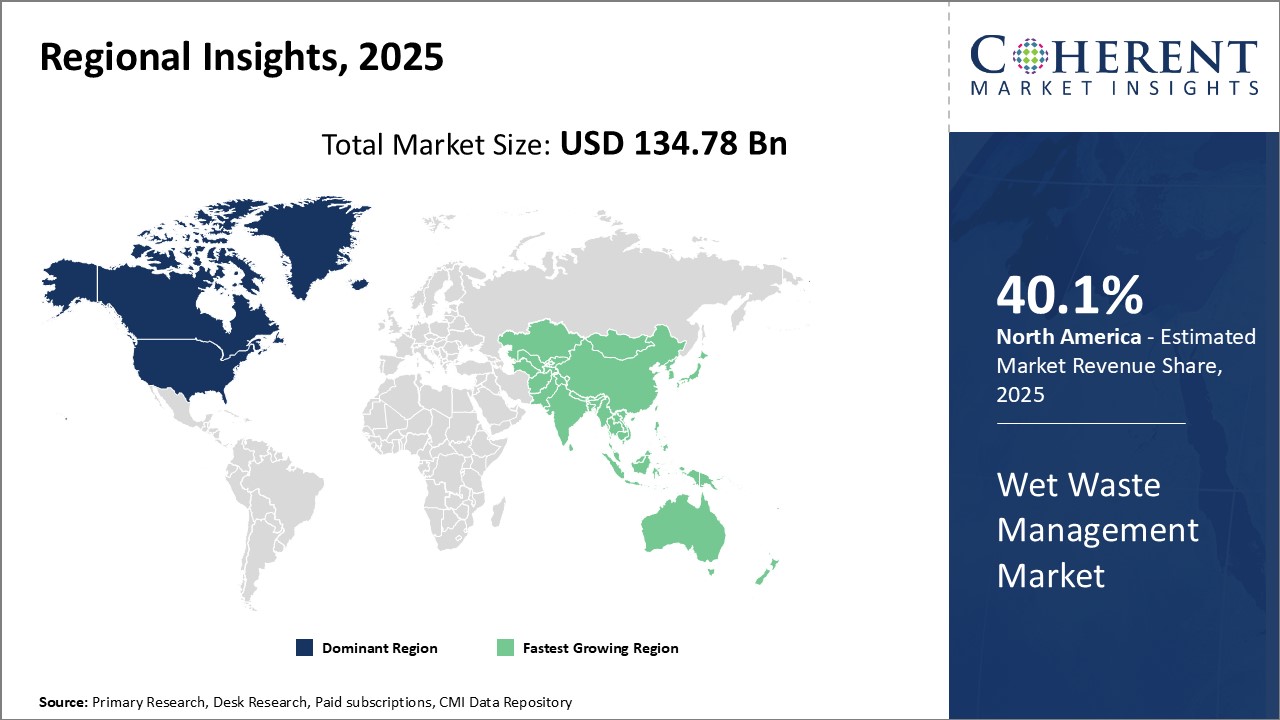
Need a Different Region or Segment? Download Free Sample
North America has established itself as the dominant region along with market share of 40.1% in the global wet waste management market. The region has a highly developed wet waste collection and treatment infrastructure in place, especially in the US and Canada. Stringent regulations regarding the handling and treatment of wet waste have propelled investments in advanced technologies across major cities. Several countries have implemented pay-as-you-throw policies that have boosted waste diversion rates. Companies in the region are at the forefront of innovating new collection routes and trucks that improve operational efficiency. They are also increasingly using location-based data analytics to optimize collection schedules.
A key growth market is expected to be Asia Pacific. Rapid urbanization and economic development have led to a surge in wet waste generation. However, most countries in the region are still in the nascent stages of developing formal waste management systems. Collection rates remain quite low while open dumping and burning continue to be prevalent disposal practices. This presents a massive opportunity for service providers to work closely with municipal bodies to design and operate integrated systems. Many global industry participants have entered strategic partnerships to provide localized solutions and transfer technical know-how. Increased public-private investments are helping expand services to cover more residential and industrial areas.
Market Report Scope
Wet Waste Management Market Report Coverage
| Report Coverage | Details | ||
|---|---|---|---|
| Base Year: | 2024 | Market Size in 2025: | USD 134.78 Bn |
| Historical Data for: | 2020 To 2024 | Forecast Period: | 2025 To 2032 |
| Forecast Period 2025 to 2032 CAGR: | 1.6% | 2032 Value Projection: | USD 150.72 Bn |
| Geographies covered: |
|
||
| Segments covered: |
|
||
| Companies covered: |
Waste Management Inc., Republic Services, Inc., Veolia Environment S.A., Suez Environment, Clean Harbors Inc., Progressive Waste Solution Ltd., Stericycle, Advanced Disposal, Covanta, Remondis SE & Co. Kg, Biffa PLC |
||
| Growth Drivers: |
|
||
| Restraints & Challenges: |
|
||
Uncover macros and micros vetted on 75+ parameters: Get instant access to report
Wet Waste Management Industry News
- In June 2022, Clean Harbors Inc.'s subsidiary, Safety-Kleen introduced the KLEEN+ brand of base oils, which is a revolutionary combination of sustainability and superior quality. KLEEN+ base oils are manufactured through a closed-loop process that re-refines used oil, resulting in a product that reduces greenhouse gas emissions by up to 78% compared to traditional refining methods.
- June 2022, SUEZ partners with FDJ as the leading co-sponsor of the top French women’s cycling team FDJ-SUEZ-Futuroscope
- In April 2022, Veolia launched an innovative industrial solution to produce CO₂-neutral biofuel from pulp production. The project, located in Finland, is the world's largest biorefinery producing CO₂-neutral bio-methanol from a pulp mill. This biofuel will contribute to European energy security and support the European Green Deal decarbonization ambitions for transportation.
- In May 2022, Republic Services and Archaea Energy announced a landmark joint venture to develop 39 new renewable natural gas (RNG) projects across the United States. This strategic partnership is the country's largest RNG portfolio build-out to date, with both companies contributing approximately USD1.1 Bn over five years.
*Definition: The global wet waste management market consists of companies that collect, transport, and process wet waste generated primarily from residential and commercial sources. Wet waste includes food scraps, spoiled food items, plant debris from parks and gardens, sewage sludge from wastewater treatment plants, and animal manure.
Market Segmentation
- Service Insights (Revenue, USD Bn, 2020 - 2032)
- Collection & Transportation
- Processing
- Disposable & Landfill
- Others
- Source Insights (Revenue, USD Bn, 2020 - 2032)
- Industrial
- Municipal
- Commercial
- Healthcare & Medical
- Others (Construction & Demolition, etc.)
- Regional Insights (Revenue, USD Bn, 2020 - 2032)
- North America
- U.S.
- Canada
- Latin America
- Brazil
- Argentina
- Mexico
- Rest of Latin America
- Europe
- Germany
- U.K.
- Spain
- France
- Italy
- Russia
- Rest of Europe
- Asia Pacific
- China
- India
- Japan
- Australia
- South Korea
- ASEAN
- Rest of Asia Pacific
- Middle East & Africa
- GCC Countries
- Israel
- Rest of Middle East & Africa
- North America
- Key Players Insights
- Waste Management Inc.
- Republic Services, Inc.
- Veolia Environment S.A.
- Suez Environment
- Clean Harbors Inc.
- Progressive Waste Solution Ltd.
- Stericycle
- Advanced Disposal
- Covanta
- Remondis SE & Co. Kg
- Biffa PLC
Share
Share
About Author
Shivam Bhutani has 6 years of experience in market research and strategy consulting. He is a Market Research Consultant with strong analytical background. He is currently an MBA candidate specializing in Business Analytics from BITS Pilani.
He is adept at navigating diverse roles from sales and marketing to research and strategy consulting. He excels in market estimation, competitive intelligence, pricing strategy, and primary research. He is skilled at analysing large datasets to provide precise insights, helping clients in achieving strategic transformation across various industries. He is skilled in leveraging data visualization techniques to drive innovation and enhance business processes.
Missing comfort of reading report in your local language? Find your preferred language :
Transform your Strategy with Exclusive Trending Reports :
Frequently Asked Questions
EXISTING CLIENTELE
Joining thousands of companies around the world committed to making the Excellent Business Solutions.
View All Our Clients
